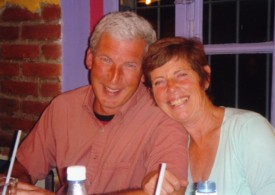Central America 2010
The ground was covered in 6 inches of snow when we left Fairford on Thursday 7 January. Because the weather was so cold and the prospect of very icy roads we elected to spend a night in a hotel a few miles from the car park at Heathrow. It was a good decision as it meant we arrived at the airport on Friday morning early and hassle free. Our flights went without a hitch and we found ourselves at our hotel in Mexico City by 9:30 pm local time. The next morning it was cold and raining (It rarely rains in Mexico City in January and the temperature was 20F below normal). We spent the day pottering and orientating ourselves before the rest of our travel companions gathered in the evening. We were a total of 18 plus a Mexican tour leader Ernesto.
We spent a day looking at sights in central Mexico City travelling on foot, by Metro and local bus. We also watched a ‘land Fertility’ ceremony which involved men suspended by ropes from a very tall pole. As they rotated around the pole so they descended suspended upside down.
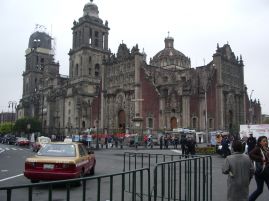

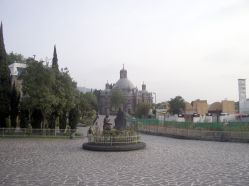
It was a good day although the weather continued to be cold and dull. The next day we visited the Basilica de Guadalupe complex comprising of a number of old churches as well a very large and round modern church. We visited early in the morning so had few other tourists around. (This was a key policy adopted by Ernesto throughout our trip and well worth early starts).
From there we went to our first Aztec site at Chapultepec.  It was very large and included 2 large pyramids called the Sun and Moon Temples (shown here as seen from the other end of the site). Gerry climbed to the top of the Sun Temple and was rewarded with some amazing views.
It was very large and included 2 large pyramids called the Sun and Moon Temples (shown here as seen from the other end of the site). Gerry climbed to the top of the Sun Temple and was rewarded with some amazing views.
The manpower involved in construction of the site was astounding and clearly took many years or even centuries for the site to reach its final size – a theme that prevailed through all of the sites we were to visit.
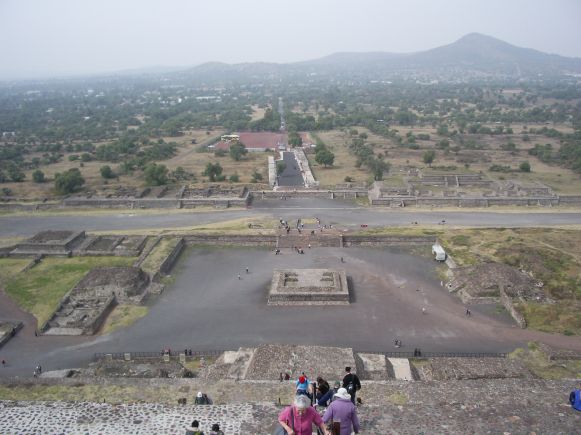
The final part of the day was spent on a walking tour looking at the fascinating mix of different architectural styles in Downtown Mexico City. We seemed to see so much and yet so little of such a large city.
From Mexico City we headed to Oaxaca.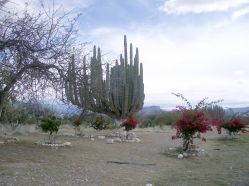 During the 7 hour drive we saw the Popokatepetl volcano in the hazy distance and a National Cactus park. We only saw a very small example of the different varieties but it was a nice break from the drive. The whole journey was a contrast in lush vegetation and barren stretches, flat plains and mountains, and poor and wealthy areas. Oaxaca was a lovely city full of character and history but we especially enjoyed sitting in the Central Square watching life pass by and listening to the band playing in the bandstand as well as walking through the markets with so much on display including baked grasshoppers (a great source of protein) laced with chilli (OK says Gerry but not something to die for).
During the 7 hour drive we saw the Popokatepetl volcano in the hazy distance and a National Cactus park. We only saw a very small example of the different varieties but it was a nice break from the drive. The whole journey was a contrast in lush vegetation and barren stretches, flat plains and mountains, and poor and wealthy areas. Oaxaca was a lovely city full of character and history but we especially enjoyed sitting in the Central Square watching life pass by and listening to the band playing in the bandstand as well as walking through the markets with so much on display including baked grasshoppers (a great source of protein) laced with chilli (OK says Gerry but not something to die for). 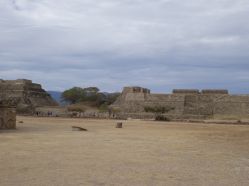 Oaxaca also boasted the Monte Alban site which we visited early the next morning. This was a large site on the flattened top of the ‘white mountain’. Surrounded by trees and flowers it was a peaceful and beautiful site with fantastic views of the surrounding landscape. Lots of temples and other buildings to see with underground passages between two temples that G ventured into. We also saw our first example of a Pelota Court where opponents tried to pass large natural rubber balls through stone hoops set high on the side of the court. We saw many such examples throughout the rest of our visit and although our guides could not be certain, they thought that either the winners or losers were sacrificed after a game – an interesting debate. From Monte Alban we travelled to Mitla via the town of Santa Maria Del Tule where we saw the largest living organism in Mexico – a 2000plus year old cypress tree 14 metres in diameter.
Oaxaca also boasted the Monte Alban site which we visited early the next morning. This was a large site on the flattened top of the ‘white mountain’. Surrounded by trees and flowers it was a peaceful and beautiful site with fantastic views of the surrounding landscape. Lots of temples and other buildings to see with underground passages between two temples that G ventured into. We also saw our first example of a Pelota Court where opponents tried to pass large natural rubber balls through stone hoops set high on the side of the court. We saw many such examples throughout the rest of our visit and although our guides could not be certain, they thought that either the winners or losers were sacrificed after a game – an interesting debate. From Monte Alban we travelled to Mitla via the town of Santa Maria Del Tule where we saw the largest living organism in Mexico – a 2000plus year old cypress tree 14 metres in diameter.
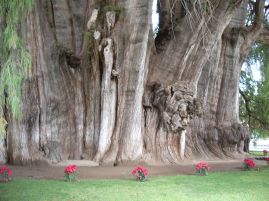
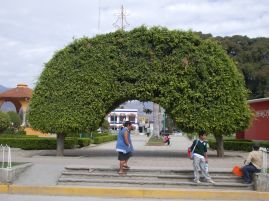
It was amazing to look at and set in some beautiful grounds with fine examples of topiary. Interestingly we saw many other examples of topiary during the rest of our travels.
Surrounded by the town buildings, Mitla was a much smaller site that had not been excavated carefully (Ernesto was very cross about this as so much information had been lost). Nevertheless we saw the remains of wall paintings and ornamental stone frieze work. The latter being very well preserved and intricate.
Mitla was a much smaller site that had not been excavated carefully (Ernesto was very cross about this as so much information had been lost). Nevertheless we saw the remains of wall paintings and ornamental stone frieze work. The latter being very well preserved and intricate.
As was typical around such sites there were many colourful market stalls selling everything from local artisans’ handiwork to tacky souvenirs.
After a visit to a local rug making factory we headed back to Oaxaca to visit the Church of San Domingo. Built around 1520 the interior is exquisitely decorated and painted in gold – It was breathtaking but unfortunately flash photography was not allowed and our photographs did not do it justice.
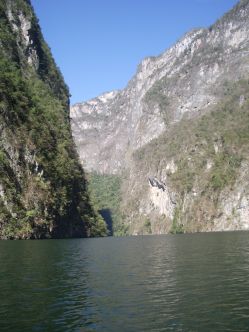 The next morning we set off on a very long, bumpy windy and mountainous drive to Chiapa Del Corzo.
The next morning we set off on a very long, bumpy windy and mountainous drive to Chiapa Del Corzo.
We arrived after dark and because the square was filled with a fairground (and lots of people and market stalls) we had to walk quite a way to our hotel. The town was celebrating its saint’s day and we were kept awake for most of the night with music and very loud fireworks.
Following a cold and noisy night we set off to visit the Sumidero Canyon. We donned life jackets and set off in a speed boat for a 56 km round trip up the canyon. At one point it was 1 km deep but more generally about 350 m. The wild life was prolific including buzzards, cormorants, herons, crocodiles and iguanas. It was a lovely trip and well worth doing if you ever visit the area.
We next visited the hill top town of San Juan Chamula. 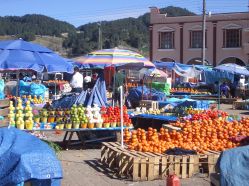
 The sun was shining and the sky bright and cloudless above the bustling and colourful market place. The locals were generally quite short and facially different to other locals we had seen so far. The women also wore wonderful outfits – a heavy goats’ wool skirt, brightly coloured blouse and a 6 inch wide belt like a cummerbund. We could have spent hours just watching the scene but we were ushered into the church where we learned about the peculiarities of the area.
The sun was shining and the sky bright and cloudless above the bustling and colourful market place. The locals were generally quite short and facially different to other locals we had seen so far. The women also wore wonderful outfits – a heavy goats’ wool skirt, brightly coloured blouse and a 6 inch wide belt like a cummerbund. We could have spent hours just watching the scene but we were ushered into the church where we learned about the peculiarities of the area.
Although nominally Catholic (forced on the locals by the Spanish conquerors) the population retained their original religious traditions – no pews – floor strewn with pine needles, healers holding sessions with the sick providing eggs and/or chickens amongst other things and lighting hundreds of candles. The catholic priest only shows up once in a while!!!
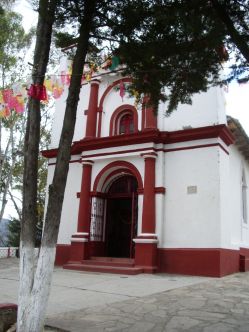 Our next town was San Cristobal De Las Casas. Where we spent a couple of days enjoying the churches, town square (with lots of music) and the colourful markets as well as the pedestrianised ‘Avenue Turistico’. We set off on our own to explore and climbed through the houses on the side of a hill to visit the beautiful San Cristobalito Church overlooking the town,
Our next town was San Cristobal De Las Casas. Where we spent a couple of days enjoying the churches, town square (with lots of music) and the colourful markets as well as the pedestrianised ‘Avenue Turistico’. We set off on our own to explore and climbed through the houses on the side of a hill to visit the beautiful San Cristobalito Church overlooking the town, 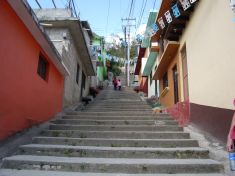
The days were hot but the nights cold!!!!
We next visited the site at Tonina in the middle of the jungle. 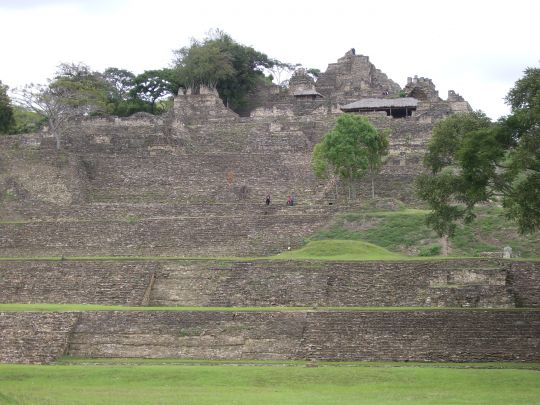
What a place – an enormous tall Mayan temple that had been discovered relatively recently, was not ‘touristified’ and had not been the subject of significant restoration. 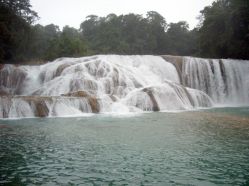 We both thoroughly enjoyed the place although Annie did not climb the 260 steps to the top. Our journey continued to Palenque via the Agua Azul Waterfalls. We arrived late afternoon under dark skies and in a light drizzle. It was enough to spoil the wonderful colours that are normally evident but it was still a beautiful sight. The waterfalls were a long series of cascades over large rocks that rose high into the hills. Apparently Pepsi Cola has tried several times to buy the water for bottling!!
We both thoroughly enjoyed the place although Annie did not climb the 260 steps to the top. Our journey continued to Palenque via the Agua Azul Waterfalls. We arrived late afternoon under dark skies and in a light drizzle. It was enough to spoil the wonderful colours that are normally evident but it was still a beautiful sight. The waterfalls were a long series of cascades over large rocks that rose high into the hills. Apparently Pepsi Cola has tried several times to buy the water for bottling!!
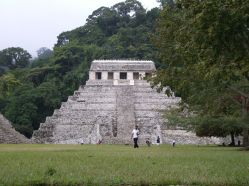 Our visit to the ruins at Palenque took nearly 3 hours. The temples were huge and covered a large area but the place was already (for us anyway) full of tourists by the time we arrived and the magic we had experienced at other sites was somewhat diminished by their presence. Nevertheless we enjoyed seeing yet another quite different style of buildings although the theme of building high was consistent and one temple (shown on the left) was quite spectacular.
Our visit to the ruins at Palenque took nearly 3 hours. The temples were huge and covered a large area but the place was already (for us anyway) full of tourists by the time we arrived and the magic we had experienced at other sites was somewhat diminished by their presence. Nevertheless we enjoyed seeing yet another quite different style of buildings although the theme of building high was consistent and one temple (shown on the left) was quite spectacular.
 The next day we set off for Bonampak covering the last 4 km over a rutted and windy track in mini buses. This was a smaller site but with Ernesto acting as our guide rather than the local guide we had to employ at Palenque, we all seemed to enjoy it much more. By this stage of the trip we were all beginning to understand the Mayan calendar and the significance of the different sites and cultures they represented (I put this down to Ernesto whose enthusiasm was certainly rubbing off on the group). From here we travelled to an ‘ecotourist’ hotel in Yaxchillan run by the indigenous people on behalf of the community. Although relatively inexperienced as ‘hoteliers’ they did well even if the accommodation was very basic.
The next day we set off for Bonampak covering the last 4 km over a rutted and windy track in mini buses. This was a smaller site but with Ernesto acting as our guide rather than the local guide we had to employ at Palenque, we all seemed to enjoy it much more. By this stage of the trip we were all beginning to understand the Mayan calendar and the significance of the different sites and cultures they represented (I put this down to Ernesto whose enthusiasm was certainly rubbing off on the group). From here we travelled to an ‘ecotourist’ hotel in Yaxchillan run by the indigenous people on behalf of the community. Although relatively inexperienced as ‘hoteliers’ they did well even if the accommodation was very basic.
The site at Yaxchillan was approached by an 8 km boat ride along the river. Again we arrived before the tourists and had the place to ourselves – wonderful. The ruins were enchanting – a huge sits accessed up a path through the jungle.
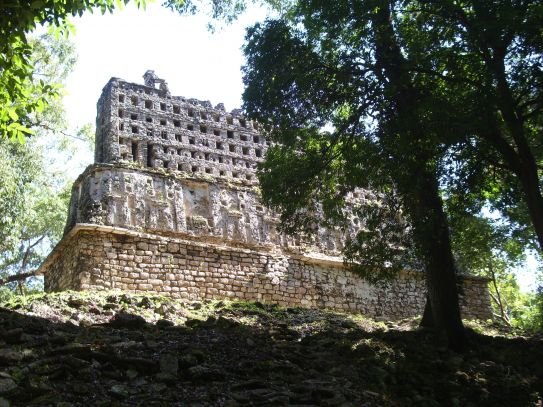 We only had 2 hours but could have done with more as there was so much to see and learn. But we then headed back up river to collect our bags and then continue for another half an hour in the boats to the border crossing with Guatemala on the other side of the river.
We only had 2 hours but could have done with more as there was so much to see and learn. But we then headed back up river to collect our bags and then continue for another half an hour in the boats to the border crossing with Guatemala on the other side of the river.
Click here for more photos of our journey so far.
The border crossing was accomplished by Ernesto – we remained in the minbus whislt he took our passports and got them stamped. He had done the same whenwe left Mexico (I wish all border crossings were so easy). Initially the roads in Guatemala were no more than gravel covered tracks ravaged by recent heavy rains.  Not surprisingly we got a puncture fairly early on but that was soon fixed. We tried to find a restaurant for some lunch but the proprietor of the only one we found laughed when asked whether she could feed 18 and explained that she did not have enough food or even wood to cook!!!! We continued and the roads got better and a petrol station provided a place to buy some snacks. Eventually we arrived on the island at Flores an incredibly touristy town but with good restaurants, bread shops and internet cafes. (The island shown is a smaller island not the one we stayed on!)
Not surprisingly we got a puncture fairly early on but that was soon fixed. We tried to find a restaurant for some lunch but the proprietor of the only one we found laughed when asked whether she could feed 18 and explained that she did not have enough food or even wood to cook!!!! We continued and the roads got better and a petrol station provided a place to buy some snacks. Eventually we arrived on the island at Flores an incredibly touristy town but with good restaurants, bread shops and internet cafes. (The island shown is a smaller island not the one we stayed on!)
Annie  chose to enjoy a day in Flores whilst Gerry travelled 60km to explore the massive spread out complex of Tikal deep in the jungle. There are many buildings and temples some of which rise way above the forest canopy. It was a long climb to a 3ft wide platform that slopes forward but the view was amazing and worth the panic felt by most.
chose to enjoy a day in Flores whilst Gerry travelled 60km to explore the massive spread out complex of Tikal deep in the jungle. There are many buildings and temples some of which rise way above the forest canopy. It was a long climb to a 3ft wide platform that slopes forward but the view was amazing and worth the panic felt by most.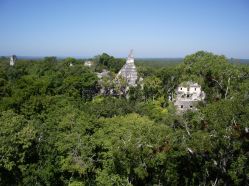
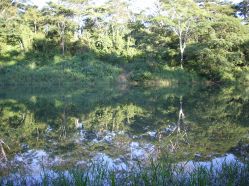 The next day we had a short drive to the Guatemala–Belize border and on to San Ignacio passing lush green countryside with Palm trees citrus groves and lots of cattle – all very beautiful but houses were often no more than wooden shacks and life appeared very simple and hard. Our accommodation was a small wooden cabin on stilts but it had air conditioning. We strolled through the grounds to the river which had incredible reflections of the trees. Because of the humidity the heat was exhausting and we seemed to just laze away the afternoon and evening.
The next day we had a short drive to the Guatemala–Belize border and on to San Ignacio passing lush green countryside with Palm trees citrus groves and lots of cattle – all very beautiful but houses were often no more than wooden shacks and life appeared very simple and hard. Our accommodation was a small wooden cabin on stilts but it had air conditioning. We strolled through the grounds to the river which had incredible reflections of the trees. Because of the humidity the heat was exhausting and we seemed to just laze away the afternoon and evening.
 It was a good job we rested because the next day we drove to Belize City and a 45 minute speedboat ride to the island Caye Caulker. This was a beautiful small island existing solely on tourism!! We spent our weekend walking the length of the island and enjoying sitting in the sun overlooking the sea – very restful (but windy early in the morning). After 2 days R and R we walked to the airstrip whilst our luggage went by golf cart (the only form of transport allowed on the island) for a 40 minute flight in two 9 seater aircraft to Corozal.
It was a good job we rested because the next day we drove to Belize City and a 45 minute speedboat ride to the island Caye Caulker. This was a beautiful small island existing solely on tourism!! We spent our weekend walking the length of the island and enjoying sitting in the sun overlooking the sea – very restful (but windy early in the morning). After 2 days R and R we walked to the airstrip whilst our luggage went by golf cart (the only form of transport allowed on the island) for a 40 minute flight in two 9 seater aircraft to Corozal.
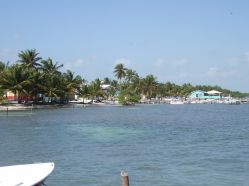
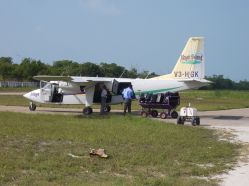
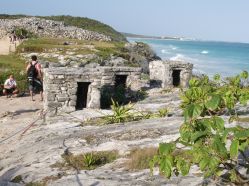 We then travelled in two people carriers to the border and crossed back into Mexico and the Yucatan Peninsula before heading to the Mayan site of Tulum situated on the coast. The Yucatan Peninsula is touristy with many coming ashore from large cruise shops. I am sure that you can imagine what that did for prices, crowds and restrictions on where we could go on historic sites. Tulum was a fine example – roped off paths beautifully manicured grounds and most people in it to take photographs and tick the site off their list.
We then travelled in two people carriers to the border and crossed back into Mexico and the Yucatan Peninsula before heading to the Mayan site of Tulum situated on the coast. The Yucatan Peninsula is touristy with many coming ashore from large cruise shops. I am sure that you can imagine what that did for prices, crowds and restrictions on where we could go on historic sites. Tulum was a fine example – roped off paths beautifully manicured grounds and most people in it to take photographs and tick the site off their list. Nevertheless, we enjoyed an hour walking around the place and appreciating the differences that a coastal site had over jungle based sites. We then spent the night at Playa Del Carmen –crowded and full of loud tourists and tourist shops (Yuk). That said we had our first Mexican food that was anything like we have been used to i.e. texmex. Up until then Mexican food had generally been quite spicy but lacking in real taste and with hardly anything for a vegetarian!
Nevertheless, we enjoyed an hour walking around the place and appreciating the differences that a coastal site had over jungle based sites. We then spent the night at Playa Del Carmen –crowded and full of loud tourists and tourist shops (Yuk). That said we had our first Mexican food that was anything like we have been used to i.e. texmex. Up until then Mexican food had generally been quite spicy but lacking in real taste and with hardly anything for a vegetarian!
From Playa Del Carmen we headed off to stay in a very run down town called Piste. The town has suffered severely in the recession and many businesses have closed down and our hotel, which must have been a fantastic place a few years ago was run down and the extensive grounds and facilities unkempt, closed or simply dirty. What a shame. However, it was a good base from which to visit the last 2 sites on our sojourn.  The first was Chichen Itza. We arrived as it opened and before even the vendors had set up the hundreds of souvenir and craft stalls. We had a very good local guide and we were able to spend a good 2 hours exploring the large site.
The first was Chichen Itza. We arrived as it opened and before even the vendors had set up the hundreds of souvenir and craft stalls. We had a very good local guide and we were able to spend a good 2 hours exploring the large site. 
The site comprised of a large religious area in the middle surrounded by the remains of a wall which separated the living (thought to be about 250,000 people) and commercial sections from the religious. 
Once again this was a very touristy site and we were not permitted to climb any of the temples or other buildings or even get up really close to examine the carvings etc. Nevertheless, it was very impressive and we enjoyed the time and gained some understanding of the nature of this fairly modern site abandoned about 1000 years ago. Not only that but we left just as the first of the big tour coaches from a cruise ship started to arrive!!!!
From Chichen Itza we headed to Uxmal but enroute Ernesto stopped to show us an archaeological dig going on at the church in Piste. It was fascinating to see what they were uncovering and how it was explaining how the church had changed and been rebuilt over the last 500 years.
 Uxmal was probably even better than Chichen Itza- we saw the massive magicians pyramid and a variety of massive buildings all with amazing and original reliefs on the walls. They were so clear. We also came across yet another Pelota Court (not as good as that at Chichen Itza) but grand and well preserved. Outside the main religous complex we found the Observatory and a system used to store water. Of all the different views I particularly liked the amazing structure shown below.
Uxmal was probably even better than Chichen Itza- we saw the massive magicians pyramid and a variety of massive buildings all with amazing and original reliefs on the walls. They were so clear. We also came across yet another Pelota Court (not as good as that at Chichen Itza) but grand and well preserved. Outside the main religous complex we found the Observatory and a system used to store water. Of all the different views I particularly liked the amazing structure shown below.

So concluded our visit to the major Aztec and Mayan sites in Mexico and Guatemala. We have learned a lot and thanks to Ernesto’s enthusiasm and ability to communicate this to us, far from being templed out, found ourselves looking forward to successive sites.
 Our final town was Merida where we enjoyed a day looking at the old city before setting out to return to the UK. Our journey should have been straightforward with a flight to Mexico City and then onto Gatwick. Unfortunately we hit a bird shortly after leaving Merida and had to return. The ensuing delay meant we missed our connection for Gatwick. However, a very efficient Mexicana employee got us on a flight to Madrid 90 minutes later and organised a flight form Madrid to Heathrow. Not only that but he managed to sort out our luggage so that arrived at Heathrow with us.
Our final town was Merida where we enjoyed a day looking at the old city before setting out to return to the UK. Our journey should have been straightforward with a flight to Mexico City and then onto Gatwick. Unfortunately we hit a bird shortly after leaving Merida and had to return. The ensuing delay meant we missed our connection for Gatwick. However, a very efficient Mexicana employee got us on a flight to Madrid 90 minutes later and organised a flight form Madrid to Heathrow. Not only that but he managed to sort out our luggage so that arrived at Heathrow with us.
Click here for more photos of the second part of our journey.
So another adventure ended. It was a fantastic experience and one that we thoroughly enjoyed.

